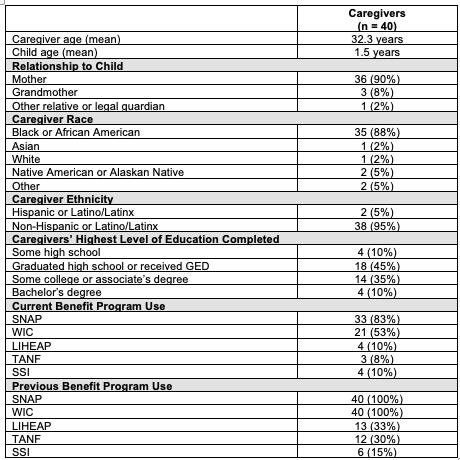Health Equity/Social Determinants of Health
Health Equity/Social Determinants of Health 10
597 - Caregiver Perspectives on Improving Government Nutrition Benefit Programs
Monday, May 1, 2023
9:30 AM - 11:30 AM ET
Poster Number: 597
Publication Number: 597.411
Publication Number: 597.411
DanaRose Negro, Children's Hospital of Philadelphia, Philadelphia, PA, United States; Mishaal Yazdani, Children's Hospital of Philadelphia/PolicyLab, Philadelphia, PA, United States; Lindsay Benitez, Sidney Kimmel Medical College at Thomas Jefferson University, Philadelpia, PA, United States; Chen Kenyon, Childrens Hospital of Philadelphia, Philadelphia, PA, United States; Alex G. Fiks, Childrens Hospital of Philadelphia, Merion Station, PA, United States; Aditi Vasan, Children's Hospital of Philadelphia, Philadelphia, PA, United States

DanaRose Negro, BS (she/her/hers)
Medical Student
Children's Hospital of Philadelphia
Philadelphia, Pennsylvania, United States
Presenting Author(s)
Background: The Special Supplemental Nutrition Program for Women, Infants, and Children (WIC) and the Supplemental Nutrition Assistance Program (SNAP) are government benefit programs that provide nutrition support for food insecure children and families. However, only about 50% of WIC-eligible families and 75% of SNAP-eligible families currently receive these benefits.
Objective: To understand current and former WIC and SNAP beneficiaries’ perceived barriers to participation in these programs and their suggestions for increasing WIC and SNAP enrollment and redemption.
Design/Methods: We conducted semi-structured phone interviews with 40 caregivers of pediatric patients seen at two academic pediatric primary care clinics who were current or former WIC and SNAP beneficiaries. Interviews focused on eliciting barriers to program participation and suggestions for improving participation rates. Interviews were recorded, transcribed, and coded by 2 independent coders using content analysis, resolving discrepancies by consensus. Interviews continued until thematic saturation was reached.
Results: Caregivers were predominantly Black (88%) and Medicaid-insured (100%), with 53% and 83% of caregivers currently using WIC and SNAP respectively (Table 1). We identified two primary themes related to WIC, two related to SNAP, and two common themes across programs. For WIC, caregivers felt that (1) product restrictions limit the usefulness of WIC benefits, and (2) redeeming WIC in stores can be inconvenient and stigmatizing. For SNAP, caregivers reported that (1) income-based eligibility criteria can be a barrier to participation, and (2) enrollment and recertification processes can lead to unexpected loss of benefits. Across both programs, caregivers believed that (1) enrollment processes could be improved to decrease stigma associated with participation, and (2) online or phone-based enrollment and better coordination with medical offices could help promote participation.
Conclusion(s): Previous and current WIC and SNAP beneficiaries identified several strategies for improving these programs, including expanding WIC product options and improving in-store WIC labeling, increasing SNAP income limits, and adopting more convenient and less stigmatizing enrollment and redemption processes, such as online or clinic-based enrollment, across both programs. Pediatricians should consider partnering with local WIC and welfare offices and community-based organizations to improve cross-sector data sharing, streamline benefits enrollment, and advocate for WIC and SNAP programmatic improvements.

.png)
